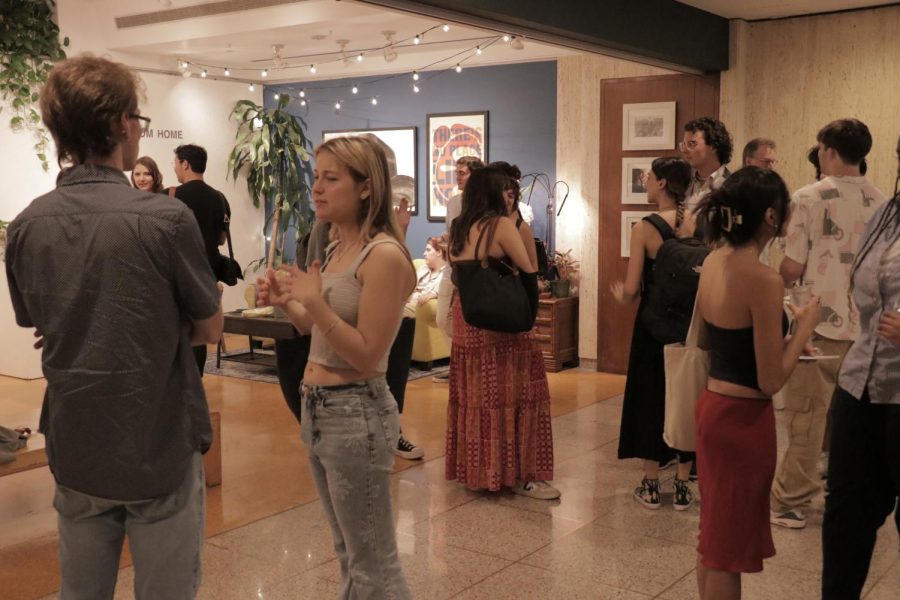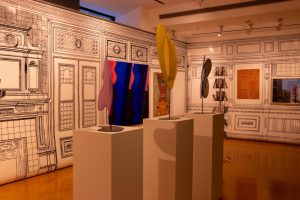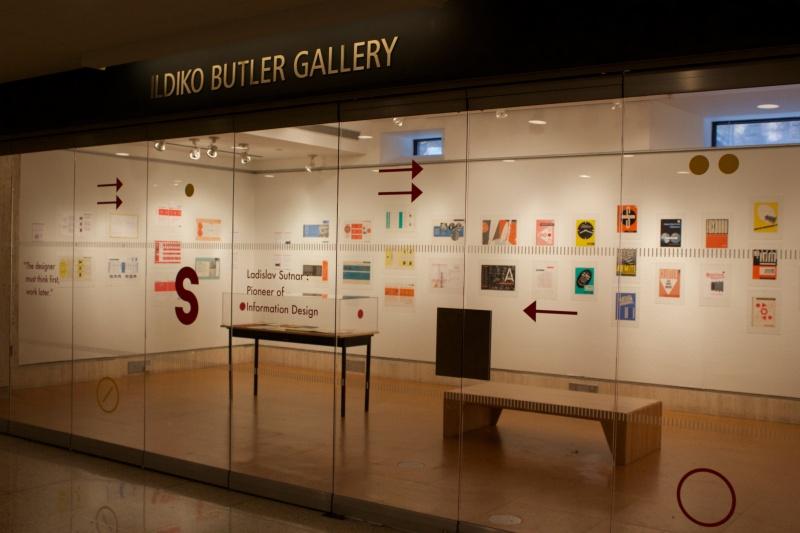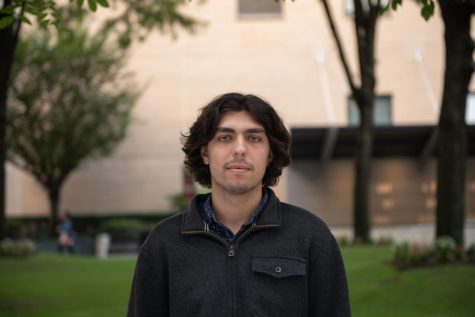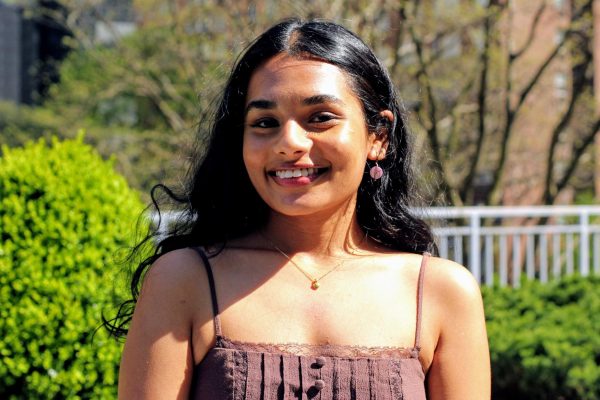Fordham Visual Arts Department Presents Senior Showcase
The exhibit features work from several Lincoln Center seniors
May 8, 2023
Lincoln Center’s Ildiko Butler Gallery was full of excitement on April 13, as the visual arts department celebrated the opening of a new exhibit as a part of its rotating Senior Seminar Showcase. The gallery was a three-part exhibit that featured Slav Velkov, Bryson Kernan Clark and Anna Tatyana Koch, all Fordham College at Lincoln Center ’23.
The showcase was the product of projects from the fall 2022 senior seminar class, which had the goal of preparing students to present their artwork to the Fordham community across both the Lipani and Ildiko Butler galleries on a rotating basis throughout the spring 2023 semester.
Velkov, Koch and Clark’s artworks communicated their perspectives on life and society and complemented one another as they each discussed aspects of their projects.
“Zavet”
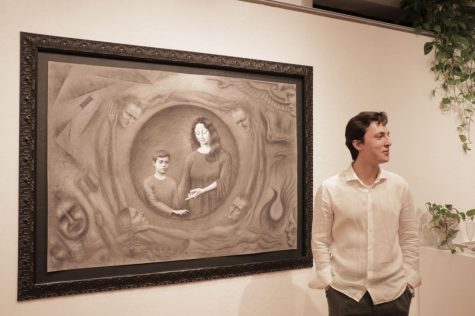
“Zavet,” is a charcoal and pencil drawing that offers a reflection on the finality and the limitations of familial and social bonds in a “Madonna and Child”-esque image. Velkov noted that he chose to work with charcoal because he wanted to place design and light at the forefront. “Color can sometimes be an easy way to attract the eye, and I wanted to grab the viewer only through light and shadow,” he said.
According to Velkov, the reason he chose “Zavet” to be the title of his work is because of the word’s dual meaning in Bulgarian, which refers to ancestral heritage and a safe space from external forces.
At the center of “Zavet” is a despondent-looking mother and her young son in a seemingly protective bubble; however, they are surrounded by pressing, yet distant, specters of historical and artistic symbolism. (If you look close enough you might even see Donald Trump.)
Velkov, Koch and Clark’s artworks communicated their perspectives on life and society and complemented one another as they each discussed aspects of their projects.
Velkov mentioned that “Zavet” is as much of a personal reflection as it is an artistic and philosophical commentary on the necessity of structure. He added that his own experience of leaving his family in Bulgaria to study in New York informs “Zavet,” as does the highly politicized world that he’s grown up in, where ideas, concepts and families have been torn apart.
“There is something mysterious about art that I cannot fully explain. I have always been fascinated by achieving some sort of an ideal; building bridges from the quotidian to the divine, whatever the divine is,” he said.
Velkov noted that the inception of this painting originated from an emphasis on form and inspirations drawn from German expressionism and metamodernist thought. He added that the focus of the piece began with a central spotlight on “line, light and shape, rather than metaphorical meaning. I was thinking about proportion and symmetry.”
The artist behind “Zavet” hopes his piece will be defined by a “breaking-out” of the deconstruction of form which he feels characterized 20th century art. Thus, his work consists of a renewed focus on form.
“Familial severance is the force that breaks apart,” Velkov said. “But, the universality of that force is what keeps society together.”
“Passerby”
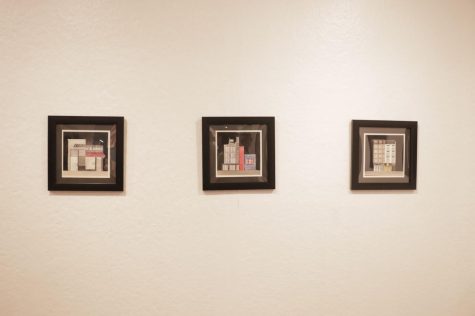
Like “Zavet,” Koch’s work, “Passerby,” ponders change but in a more familiar and grounded setting. It explores the ever-changing scenery of New York City through the perspective of her daily commute to the Lincoln Center campus on the BxM9 bus. Koch has envisioned and painted a series of works analyzing the old and new architectural landscape of New York City as she sees it.
In her paintings, Koch utilizes watercolor and India ink to offer a cut and pasted arrangement of recent architectural trends. Featured scenes include an old deli juxtaposed with a gentrified donut shop, as well as the recently closed Harlem Papaya King sharing a frame with a Chick-fil-A.
“A personal landmark, although not equivalent to a historical landmark, can hold a more profound significance for an individual,” she said.
Together, these three artworks from Velkov, Koch and Clark reflect upon the bonds developed between people and their communities, as well as highlighting the personal experiences that inspired their creations.
Koch noted that for “Passerby,” she wanted to compare buildings she loved with buildings that she hated and paid attention to buildings that were constructed following brutalist post-war structure styles.
Throughout the process of creating “Passerby,” however , she grew to love each of the buildings she paid attention to on her commute, no matter if they were old or new. “When enough care is put into a building and structure, you can always find things to appreciate about it,” she said.
Through this view, Koch too provides a reflective commentary on the constantly changing qualities of society, as well as the gentrification crisis plaguing neighborhoods across New York City. According to Koch, “Passerby” focuses on the individuals and emotions that are affected by the alterations made to a once-familiar city and said that she feels strongly that there are beautiful aspects to this city-study.
Koch noted that she wanted to deviate attention from traditional New York City skyscrapers and “focus on commercial mixed-use buildings” which would hone in on the ideas of personal and community landmarks over tourist landmarks. “I want people to look at their commutes and journeys and think about what they want from the structures in their communities,” she said.
“Passerby” serves to emphasize the beauty that an individual can find anywhere in their life, and especially during their morning commute.
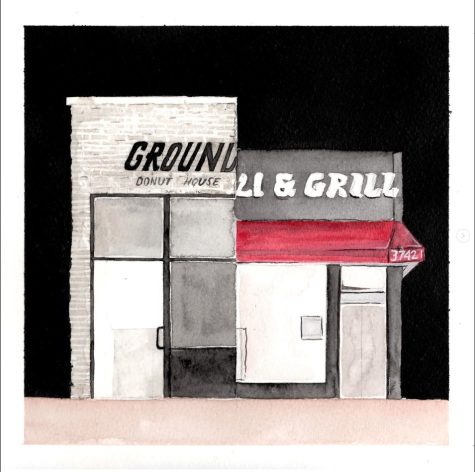
“Elements From Home”
While Velkov and Koch aimed their focus on outward societal developments, Clark looked inward and developed a still inspired by elements from his childhood home and current apartment. “Elements From Home,” according to Clark’s artist’s statement, is a testament to a “sense of aesthetics and a set of storied objects which can carry meaning through generations.” According to the statement, most of the work is repurposed from furniture left on the street corners and sidewalks of New York City.
In his mixed media artwork, Clark rejected “fast furniture,” the practice of incorporating inexpensive, short-term, disposable pieces. Instead, he favored an interior design philosophy that reflects the generational and individual history of the designer and owner, an act of embracing a more personalized form to decor.
Clark sought to design a space contrary to the “concrete jungle,” in which objects can do the “heavy lifting” in the expression of an identity that may be too complicated to phrase verbally. He explored how a space can note aspects of the designer that are both personal and profound. “Objects can speak a lot to memory and identity,” he said.
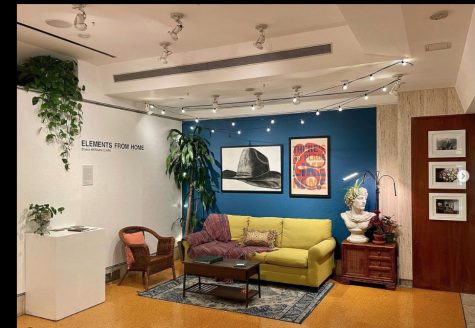
Together, these three artworks from Velkov, Koch and Clark reflect upon the bonds developed between people and their communities, as well as highlighting the personal experiences that inspired their creations. They present the transient qualities that both movement and stability bring to society and one’s personal life upon reflection, whether that be in the care and arms of one’s mother, through watching the city pass by on one’s morning bus commute or in one’s own living room.
Velkov, Koch and Clark’s joint exhibit was on display until April 30, but their artwork will return to be part of the Senior Seminar Showcase, which currently hosts a small piece of each graduating senior’s work at the Butler Gallery until the end of the semester.

